
Ford camshaft technology.
Designations & Kits
KIT COMPONENTS
Competition Cams
|
Ford, Chrysler, & General Motors Cams
Technology & Designations Street, Drag Race, Oval Tracking, Marine & Others |
RPM - RON'S PRECISION MACHINE, INC.
69 E. 580 N.
Santaquin, Utah 84655
| Engine Rebuild Kit and Parts Online Catalog. |

Ford camshaft technology.
Designations & Kits
KIT COMPONENTS
|
Cam Kits COMP Cams® offers four levels of complete component-matched valve train kits that deliver unbeatable performance, durability and ease of installation. All cam kits are fully tested and manufactured to the strictest standards. Each kit’s components were specifically chosen as the best performance match for that particular camshaft so that you can reap the benefits of a perfectly matched “Power Engineered System.” Ordering is easy. Upon selecting the proper camshaft for your application, simply add the kit prefix (“K”, “SK”, “GK” or “CL”) in front of your cam part number. For example, if you choose cam Part #12-206-2, and you want the complete kit, you should order Part #K12-206-2. * Please note that not all kits are available for every part numbered camshaft. See the application charts on the following pages to determine which kits are available for your application. ** Contents of kits may vary from application to application; components shown are typical examples. Ask for specific kit contents before ordering. K-Kit – Complete Kit SK-Kit – Small Kit GK-Kit – Gear Drive Kit - CL-Kit – Cam & Lifter Kit |
| K-Kit – Complete Kit Includes: | ||
|
• Lifters • Valve Springs • Retainers |
• Valve Locks • Valve Stem Seals • Timing Chain Set |
• Assembly Lube • Decals • Instructions |

|
||
| GK-Kit – Cam & Gear Kit Includes: | ||
|
• Camshaft • Lifters |
• Gear Drive • Assembly Lube |
• Decals • Instructions |
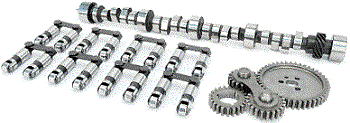
|
||
| Rocker Arm Kits | ||
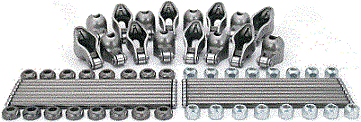
|
||
|
All rocker arm kits include quality COMP Cams® roller rocker
arms and matching pushrods. Some applications also come with
precision guide plates and rocker arm studs. Consult the related
components section of your camshaft of choice to determine if a rocker kit is available. |
||
| SK-Kit – Small Kit Includes: | ||
|
• Camshaft • Lifters |
• Timing Chain Set • Assembly Lube |
• Decals • Instructions |

|
||
| CL-Kit – Cam & Lifter Kit Includes: | ||
|
• Camshaft • Lifters |
• Assembly Lube • Decals |
• Instructions |
 |
||
| Valve Spring Kits | ||

|
||
| These valve spring kit offerings include carefully matched Beehive™ or dual valve springs, steel or titanium retainers, locks, seals and spring seats. Please see page 288, for specific kit components and application listings. | ||
|
Xtreme Energy™ • Quicker opening lobe profiles deliver increased responsiveness & more area under the lift curve • More vacuum allows an increase in duration for improved performance and assists power brakes • Excellent performance in street carbureted applications • Best performance with aftermarket intake manifolds, headers, lower gear ratios, etc. LSR™ • Take advantage of today’s newer and better flowing aftermarket cylinder heads • Feature higher exhaust duration and overall lift to provide broadest powerband and most top end power of any COMP Cams® LS camshaft • Unique grinds for both cathedral & rectangle port heads • Require 26926-16 $428.22 high pressure valve springs Thumpr™ • Three unique cam designs for each application that deliver excellent horsepower gains and broad torque curve; perfect choice for muscle cars and street rods • Early intake valve opening and long exhaust duration create optimum overlap for powerful, hard-hitting exhaust note • Best with aftermarket converters and more rear gear High Energy™ • Works well with mainly stock components (rockers, manifolds, heads, compression, converters, gears, etc.) • Good blend of efficiency and performance • Perfect choice for performance street rebuilds Dual Energy™ Benefits: Similar to High Energy Cams™, but may work better at high rpm when coupled with headers because of added exhaust duration • Work great with most stock components • Very flat torque curve for great streetability Important Considerations: • Do not work well with restrictive exhaust systems • Larger exhaust does not give a sharp early torque peak • Our other cams make more power if other components are changed Magnum • Great high RPM power • Easy on valve train parts • Can be used with mild ratio rocker arms and traditional performance valve springs • Best with aftermarket converter and 9.5:1+ compression XFI™ • Newest and quickest lobe profiles in the Xtreme family; provide a terrific increase in performance • Tuned for use in EFI applications where extra air flow signal through the carburetor is not required (feature wider lobe separation without loss of responsiveness) • Works well with aftermarket cylinder heads & feature high lift Xtreme Marine™ • Extremely wide powerband helps get boat on plane while making maximum horsepower • Work against exhaust systems with restrictive back pressure • Power enhancement helps maintain top end speed for long distances • Intended for applications where low idle speeds are required Xtreme 4x4™ • Improved throttle response and increased low & mid-range RPM horsepower for towing and off-road • Designed for use with common restrictive factory exhaust systems, including OEM exhaust manifolds |
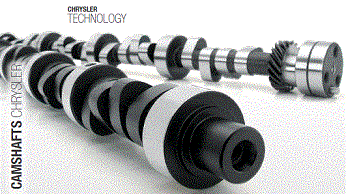
| Chrysler, one of the most dominant names during the early “Muscle Car” era, has developed five basic series of engines which are popular choices in racing, street performance, and towing applications. For our purposes we will refer to the 273-360 Small Block Chrysler engines as the “A” engines and the 383-440 big block standard head engines as the “B” engines. Several versions of the Hemi engine were manufactured in the 50s and 60s, and in recent years, the engineers at Chrysler have introduced three versions of the V10 engine platform, as well as a new 5.7L and 6.1L Hemi design. In the following information we have attempted to pass along some common tips learned during our many years of engine building, as well as the experiences of many of our customers. We will not attempt to cover all of the little things, only the more unique and aggravating trouble spots. If ever in doubt, there are many excellent reference manuals. Mopar Performance has one of the best. It goes into great detail about Chrysler engines. |
|
Small Block, “A”, Uses “20” Prefix The basic 273-360 engines produced in the mid 1960s have remained relatively unchanged as far as the valve train is concerned. The 1964- 1991 engines used shaft type rocker arms, which required some special changes in the camshaft design to allow oil to flow to the top of the engine and into the rocker arm shafts. Most of these early engines featured either grooved or offset holes in the second and fourth cam journals. In some instances a combination of both grooves and holes were employed. You must remember that if your engine has shaft type rockers arms, there must be some groove or oiling hole combination on the cam journals. In 1992 the Magnum version of the “A” engine was changed to a pedestal-style individual rocker arm design with a non-adjustable valve train. 5.7L and 6.1L Hemi, Uses “112” and Prefixes “201 $22.26 ” In 2003 Chrysler called on the legendary Hemi cylinder head design to begin a new era in Mopar performance. This engine has the same familiar perpendicular valve arrangement but does not share any parts with the classic Hemi engine. Rocker arms are shaft mounted with a 1.6 ratio on intake and exhaust. Two rocker shafts per head are used, which is similar to the earlier Hemi. Because of this design, different length intake and exhaust pushrods are used. The newer engine also uses smaller, .842" diameter hydraulic roller lifters and a single bolt cam sprocket. There are concerns when installing aftermarket camshafts in these engines. The factory piston has a dome and no valve reliefs. Extra caution should be taken to ensure adequate piston to valve clearance. It is also necessary to deactivate the MDS (multiple displacement system) when installing and using a performance camshaft. Computer tuning must be performed to enhance drivability. In 2010, Chrysler released 5.7L, 6.1L and 6.4L Hemis that utilize Variable Valve Timing (VVT) technology to manage oil flow to a camshaft sprocket which contains a phasing device to either advance or retard camshaft timing. This no springs required design is perfect for Dodge Challengers and Chargers, Chrysler 300s, Jeeps, Dodge trucks and Mopar crate engines. Big Block “B” or “RB”, Uses “21” and “23” Prefixes The “B” and “RB” engines use two different deck height blocks. They require different length pushrods, so when considering pushrod length, remember that the 383-400 engines use a shorter pushrod than the 413-440 engines. The larger engines with the taller blocks use a pushrod that is approximately ¾" longer than the other. When converting either of these engines to adjustable rocker arms, you must also replace the pushrods. The standard pushrod used with non-adjustable rocker arms uses a pushrod with a ball on each end. COMP Cams® aluminum roller rocker arms use a pushrod with a ball on the lifter end and a cup on the rocker arm end. The COMP Cams® Ultra Pro Magnum Rocker Arm™ Kit for these engines requires a ball-ball pushrod like the standard setup, but the length is different. In either case, the correct pushrods must be used for the rocker arm type selected. |
|
Ford has produced some of the most powerful engines to ever come
out of Detroit. With the V8 engine sizes ranging from 221-460, there is an engine size and configuration to cover just about any need or application. Ford engines do have some unique characteristics not found in any other vehicle make, so in this section we will try to familiarize you with some of the more common differences. This valve train related information should help you when choosing parts or assembling your engine. |
|
Small Block, Uses “31” and “35” Prefixes This is the standard engine in most V8 applications. It has been around since the early 1960s and remains very popular today in many configurations. The Small Block Ford engine is commonly referred to as the 5.0L engine found in the Mustang for many years. This engine has become one of the most frequently modified engines Ford has ever produced. There are a few differences in the valve train of this design, but for the most part, they are the same. One thing to remember is that the 221-302 engines have a very short deck height, requiring a short pushrod. The 351W engine, on the other hand, has a tall deck and a longer pushrod. The 1985-1995 5.0L blocks differ from the earlier blocks in that the lifter bosses are taller to accommodate the hydraulic roller lifters. The base circles of the cams for these blocks are larger because of the higher position of the lifters. These engines use either a prefix “31” (289-302) or a “35” (5.0L or 351W) camshaft, depending on the firing order. SVO V8 Race Engine, Uses “35” Prefix This engine is almost always found in all out racing and is a cross between the Windsor and Cleveland designs. It utilizes a Windsor type block and a Cleveland type head. The newest of the head designs is referred to as the “Yates” head. Cleveland/Modified, Uses “32” Prefix This design was introduced in 1969 and was available as a 351 Cleveland, a 351C Boss or a 351/400 Modified. The easiest way to tell these engines from the standard small block is by looking at the front covers. The small block/SVO engines have a cast aluminum front cover and water pump housing. The Cleveland/Modified engines have a stamped steel flat front cover. Other than a few rocker arm differences, the valve train in all of these engines is very similar. Big Block FE, Uses “33” Prefix Ford’s FE engine family was introduced in 1958 and was available as either a 332 or a 352 version. Later, the range was expanded to include 390-428 versions. They have been out of production since the mid 70s but remain popular today. These engines utilize a shaft rocker arm system and can be most easily recognized by the fact that the intake manifold is very wide and extends part way under the valve covers. Almost all of the parts in the FE series are used only in this engine and are not interchangeable with other engine families. Big Block “FF”, Uses “34” Prefix The engine commonly referred to as the Big Block Ford is the 429-460 and was used in light trucks and motorhomes. It is an outstanding engine for boats, bracket racing or towing and typically has a similar but larger “Cleveland” style valve train. |
|
Modular Type Engines The Ford “Modular Engine” was introduced in the early 1990s, with the idea of designing a new generation of engines from scratch, rather than basing them on then-current production engines. They were developed to replace all existing Ford V8 pushrod engines. The “Modular” term came about because of the many interchangeable components between the SOHC and DOHC engines, as well as the ability of Ford to machine and assemble the various engines on the same assembly lines. The design focuses on low friction, excellent sealing and increased block stiffness. With a modern block and head design in 2 valve, 3 valve and 4 valve configurations, the engines are both versatile and powerful. They have a sophisticated overhead cam design in both single and dual overhead cam versions that utilize a roller finger follower to reduce friction, increase RPM potential and reduce maintenance. All of the cylinder blocks have deep skirts, and nearly all of the main caps are cross bolted. SOHC engines have cast iron blocks; DOHC engines have aluminum blocks (2003-04 Cobra has an iron block). All cylinder heads are aluminum, with very long head bolts to reduce distortion of the cylinder bores and improve sealing. The newer design also allows the accessories to be rigidly mounted directly to the block. 4.6L & 5.4L 2 Valve SOHC, Uses “102 $15.20 ” Prefix The 4.6L version of this engine first came out in the 1991 Lincoln Town Car and later was installed in the Crown Victoria, Grand Marquis, Thunderbird, and Cougar. In 1997 the 5.4L version of the 2 valve SOHC engine was introduced. This engine, known as the “Triton” truck engine, has numerous parts that are interchangeable with the modular car engines. However, not all are identical since the truck engines are built to handle more severe duty. 4.6L & 5.4L 3 Valve SOHC, Uses “127 $20.89 ” Prefix The 4.6L SOHC 3 Valve engine is available in today’s Mustangs and trucks. The engine features variable cam timing, allowing the valves to open and close earlier or later as needed for optimum power. This technology was first introduced in 2004 in the 5.4L 3 Valve DOHC engines. This engine, also known as the “Triton”, is primarily in the F-150 trucks. 4.6L & 5.4L 4 Valve DOHC, Uses “106 $18.12 ” Prefix This engine showed up first in the 1993 Lincoln Mark VIII and later in the front-wheel drive Continental. It has since been put in performance cars, such as the Mustang Cobra/GT500. 5.0L Coyote DOHC, Uses "191" Prefix Designed for the Mustang GT, this 5.0L engine produces the power of its much larger competitors. It features an all aluminum block, high flowing heads, cross-flow cooling, and Twin independent Variable Cam Timing (TiVCT). Other variations of the Coyote were created for use in the F-150 truck, Boss 302 and the Australian Falcon. |
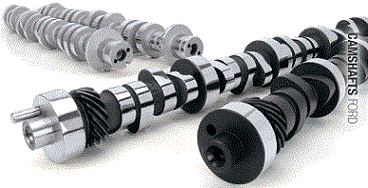
|
Firing Order, Small Block & SVO This is one of the most common questions asked by Ford customers. The firing order for the early 221-302 engines and the early 5.0 engines is 1-5-4-2-6-3-7-8. This is the firing order for all prefix “31” cams and is the standard replacement cam for all early engines. Most of the later 5.0L engine and 351 engines are designed to use the 1-3-7-2-6-5-4-8 firing order. This is the firing order for all prefix “35” cams, and cams ordered for these engines should use this prefix. However, non H.O. 302 5.0 engines use the early 1-5-4-2-6-3-7-8 firing order and require a custom grind from COMP Cams®. Other than the firing order, the cams are identical. By changing the spark plug wiring at the distributor these cams can be interchanged (only on carbureted applications or those using a FAST™ EFI system). ***EXCEPT IN MASS AIR VEHICLES*** Camshaft Dowel Pin/ Fuel Pump Ecc entric Two different length dowel pins were used in the front of the cams in 221-351W engines. In 1972 and earlier engines, a longer (1.375") dowel pin was used so that it would extend through the one-piece fuel pump eccentric used on these engines. The 1973 and later engines utilized a two-piece fuel pump eccentric which required a shorter (1.125") dowel pin. If no eccentric is used, a thicker than standard retaining washer must be used to make up for the thickness of the eccentric. The cam gear MUST be pulled tightly against the snout of the cam. If the gear is not tight against the step at the front of the cam, the cam bolt will come loose, and engine failure is sure to occur. Dowel pin failure is fairly common in Small Block Ford engines. This is almost never the result of a defective or soft dowel pin. It s most often caused by the bolt in the center of the cam loosening and allowing the dowel pin to be loaded and shear. The center bolt should always be torqued to the manufacturer’s specifications and a suitable thread lock used to prevent the bolt from backing out. |
|
Cam Phasers Cam phasers are specially designed, computer-controlled cam gears for all 2005 and newer, 3 Valve Ford Modular engines that have the ability to adjust camshaft position up to 60° while the engine is running. This helps to increase the engine’s fuel efficiency. Another benefit is that the cam phasers allow the camshafts to always be in the best position for maximum power, regardless of the engine’s RPM. The engine makes more torque and horsepower and extends the high RPM power-band by an additional 800-1000 RPM. But because there is such a wide range of movement, only fairly small cam profiles can be used without causing piston to valve clearance issues. COMP Cams® has developed the COMP Cams® Phaser Limiter Kit to eliminate this problem. These limiter plates replace the factory backplate on the cam phaser. They have posts which extend into the cam gear’s control chambers, limiting their movement to no more than 20°. This allows you to install bigger, more powerful camshafts with safe piston to valve clearances. While keeping up to 20° of movement available, all of the wide-open throttle benefits of the cam phasing is retained, since the normal retard the cams see at wide-open throttle is only around 9°. You MUST reprogram your engine’s computer for it to operate properly after installing the cam phaser limiters. Camshaft Retention Bolt Most V8 Ford engines used a 3/8" bolt to secure the upper cam gear to the cam. Almost all racing engines use a 7/16" bolt for this application. Be sure to check the compatibility of the bolt to the cam, as a 3/8" bolt in a 7/16" cam will almost certainly result in catastrophic engine failure. Most of the COMP Cams® racing roller cams will come with the 7/16" hole in the cam. |
| Small Block and Big Block Chevrolet engines have become legendary since they were introduced over 50 years ago. COMP Cams®, along with the help of top engine builders, has spent many years improving these and other Chevrolet power plants. We know the basics. And the basics are important. If you require assistance or have any questions, there are several ways we can be reached. |
|
Engine Types V6 90° V6, Uses “18”, “09” & “56” Prefixes The 4.3L V6 90° engines produced since 1985 are equipped with two types of camshafts and three types of cam drive systems. Early 1985 and 1986 engines (Prefix “18”) were produced with flat tappet cams. Hydraulic roller cams were first introduced in 1987 (Prefix “09”). These two cam types require different timing chain sets, because the hydraulic roller cams have a stepped nose like the LT1 engine as described later in this section. In 1992, a balance shaft was incorporated in this engine, which necessitated a third timing chain setup to drive both the cam and the balance shaft. The cam (Prefix “56”) in this balance shaft engine is also shorter than the earlier model and does not have a fuel pump lobe. Small Block V8 There are several varieties of small block engines currently in use in the aftermarket. Although most use the same block, the cylinder heads are very different and require totally different camshafts. The valve arrangements in the heads are different, and therefore the lobe placement on the camshafts must coincide with the head you are using.| |
|
The nose of the standard early model cam “12” is very
different from the later model hydraulic roller “08”. The nose of the hydraulic roller “08” is necked down to accommodate the cam retention plate. The “07” is an LT1/LT4 shaft, which has a longer dowel pin and a center hole for the distributor. Be sure to check the diameter and depth of the hole in the front, as well as the length of the dowel pin. COMP Cams® Standard Small Block, Uses “12” Prefix This design is the same basic small block that everyone is accustomed to. This engine configuration is found on all small blocks from 1955 until 1987, when Chevrolet introduced the roller cam. Based on the original 1955 version, with the exception of the 1955-1957 versions, which had an oiling groove in the rear journal, the camshafts are interchangeable. Hydraulic Roller, Uses “08” Prefix Beginning in 1987, most of the small block, (both V6 and V8) engines were equipped with hydraulic roller camshafts. There are differences in the block to accommodate a cam retention thrust plate and the anti-rotation mechanism for the hydraulic roller lifters. These blocks are identifiable by bolt holes for a cam retention plate behind the upper timing sprocket, as well as bosses and tapped holes in the lifter valley for the lifter retention hardware. The camshafts on these engines have a step nose and smaller bolt pattern on the front of them cam. An earlier model camshaft may be used in these blocks by using the appropriate timing chain set and adding a thrust button when using a roller cam. LT1 & LT4 Engines, Use “07” Prefix These engines are, as far as the camshaft is concerned, essentially the same as the hydraulic roller engines, with one exception. The distributor is driven from the front of the cam, requiring some changes in the cam core. There is a deeper pilot hole in the front of the cam, as well as a longer dowel pin to locate this drive. These engines require a special timing chain set, and they utilize a self-aligning rocker arm. COMP Cams® LT1 and LT4 Magnum Rocker Arms can be found on page 271. Other Variations Buick made a small block cylinder head with a different valve arrangement in the early 1980s, “19” prefix. It is still used in some drag racing and circle track applications today. GM also produced a true race engine called the SB2. It also has a different valve arrangement. When using this head with a standard GM block use prefix “03”. There is also a special SB2 block design that would require the “04” prefix. |
|
|
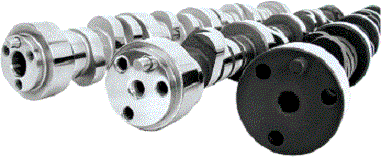
|
Big Block V8 Big Block, Uses “11” Prefix Gen VI Big Block, Uses “01” Prefix 8.1L Big Block, Uses “46” Prefix This engine was introduced in 1965 and with the exception of some of the very early 1965-1966 models that had an oiling groove in the rear journal, the camshafts are interchangeable. This includes all of the big blocks, including the Mark V, with nearly every style cylinder head until the Gen VI was introduced in 1996. The Gen VI version 454-502 Big Block is very similar to the earlier standard big block engine. The heads are interchangeable, but there is a non-adjustable valve train. It is equipped with a hydraulic roller camshaft. There is also a positive camshaft retaining plate on the front, and the nose of the cam is stepped down to accept this plate. The lifter bosses are taller to accommodate the lifter anti-rotation plates, and the engine requires a special timing chain set. The 8.1L Big Block has many differences from the previous designs. The parts are not interchangeable and it utilizes a different firing order as well. Older Engines The very first 1955-1957 265c.i. Small Blocks had a unique oiling system. The same holds true for the first 1965 and 1966 396/427 Big Blocks. When one of these blocks is used, it is necessary to machine a small groove in the ear journal of the cam to allow oil flow to the top of the engine. COMP Cams® camshafts come without this groove, so it is important to check the vintage of your block prior to camshaft installation. COMP Cams® can perform this operation or supply the specs to you for local machining. |
|
Hydraulic Roll er Cams When installing a hydraulic roller cam in an early model block, it is necessary to use a special hydraulic roller lifter with a link bar attached to keep the lifters properly located within the block. In addition, special length pushrods must also be used. A thrust button must also be used to keep the cam from “walking” in the block. When installing a flat tappet cam in a block originally equipped with a hydraulic roller, it is necessary to change the entire system. The cam, lifters, pushrods and timing chain set must all be changed in this case; none of the old parts will interchange. |
|
NOTES 1 Requires screw-in studs & guide plates 2 Requires machining on cylinder heads 5 Offset lifters available 5 Requires distributor gear upgrade 6 Offset lifters available 7 Stock springs cannot be used 8 Fits only certain years 31 These cams can only be used in 289-302 engines. NOT 302 H.O. blocks due to base circle size. 32 Requires lifter installation kit Part #31-1000 $67.02 for 55 Ford 351M and 400M engines, use Part #7824-16 $79.66 retro-fit applications pushrods on retro-fit cams 33 Pre-1972 engines use Part #3220 $43.23 35 Part #4504 studs required for 1978-present 36 1962-69 use Part #7632-16 $170.72 37 Adjustable valve train required 38 For 1.7:1 ratio use Part #RP1453-16 $274.23 39 For 1.7:1 ratio use Part #RPM1453-16 $391.80 40 Includes special shafts 50 Camshaft retaining plate Part #3120TB $169.23 recommended 55 For 351M and 400M engines, use Part #7824-16 $79.66 pushrods on retro-fit cams 56 If equipped with studs and guide plates, use Part #1442-16 $242.10 59 Requires 7/16" rocker arm studs 62 Part #7833 only works w/ non-adjustable factory rocker arms, use Part #7533 for adjustable rockers 69 Includes special rockers & shafts Part #1047-2 $414.23 70 Works with two-piece fuel pump eccentric 71 For engines with multi-groove valves, use Part #624-16 $67.05 locks. CAN NOT be used with lash caps. 72 Fits only certain heads 74 Fits only 302/351C Boss & SVO heads 93 GK-Kit contains cam, lifters & gear drive Part #1442-16 $242.10 94 Nitrided version 95 Must use #8931-16 $849.70 lifters with this cam 98 Will not work with stock length pushrods |